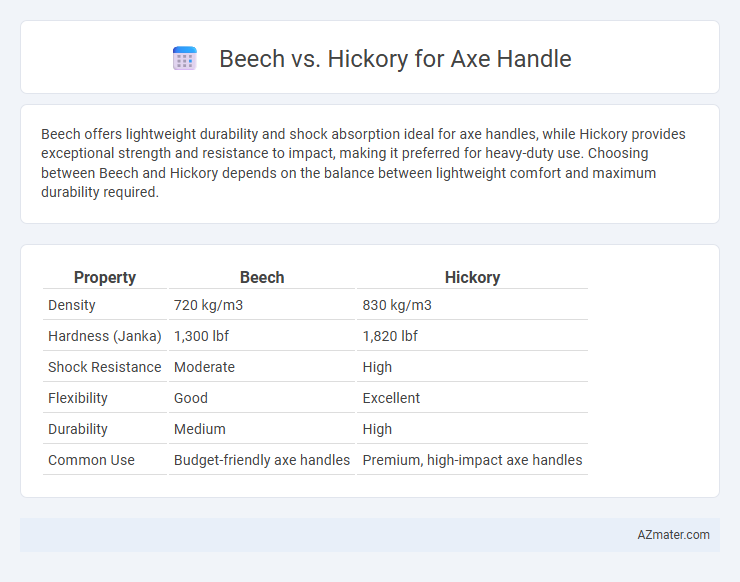Beech offers lightweight durability and shock absorption ideal for axe handles, while Hickory provides exceptional strength and resistance to impact, making it preferred for heavy-duty use. Choosing between Beech and Hickory depends on the balance between lightweight comfort and maximum durability required.
Table of Comparison
| Property | Beech | Hickory |
|---|---|---|
| Density | 720 kg/m3 | 830 kg/m3 |
| Hardness (Janka) | 1,300 lbf | 1,820 lbf |
| Shock Resistance | Moderate | High |
| Flexibility | Good | Excellent |
| Durability | Medium | High |
| Common Use | Budget-friendly axe handles | Premium, high-impact axe handles |
Introduction: Beech vs Hickory for Axe Handles
Beech and hickory are two popular hardwoods commonly used for axe handles due to their strength and shock resistance. Beech offers a fine, tight grain that provides durability and a smooth finish, while hickory is renowned for its exceptional toughness, flexibility, and capacity to absorb impact. Choosing between beech and hickory depends on the desired balance of weight, feel, and long-term resilience in axe handle performance.
Wood Density and Strength Comparison
Beech wood features a density of approximately 720 kg/m3, offering moderate strength and flexibility suitable for axe handles. Hickory, with a higher density around 830 kg/m3, provides superior toughness and shock resistance, making it a preferred choice for heavy-duty axe handles. The greater strength-to-weight ratio of hickory ensures enhanced durability and impact absorption compared to beech.
Shock Absorption and User Comfort
Beech offers moderate shock absorption with a fine, close grain that provides durability and a comfortable grip for extended use. Hickory excels in shock absorption due to its dense, fibrous structure, reducing vibration transfer to the hand and minimizing user fatigue. For axe handles, hickory's superior resilience and flexibility make it the preferred choice for optimal comfort and control during heavy chopping tasks.
Durability and Longevity of Wood Handles
Hickory offers superior durability and shock resistance compared to beech, making it the preferred choice for axe handles subject to heavy and frequent use. Beech handles, while lighter and more affordable, tend to wear faster and are more prone to cracking under intense impact. Hickory's dense fibers and natural flexibility contribute to its longer lifespan and ability to absorb repeated stress, ensuring reliable performance over time.
Weight and Balance Considerations
Beech axe handles are generally lighter, providing better maneuverability and less fatigue during extended use, while hickory handles are denser, offering increased durability and shock absorption. The weight of hickory contributes to a more balanced, solid swing, enhancing control and power transfer, whereas beech handles favor speed and responsiveness due to their lighter mass. Choosing between beech and hickory depends on the user's preference for either a lightweight, agile tool or a heavier, more stable handle that improves impact stability.
Workability for Shaping Axe Handles
Beech wood offers excellent workability for shaping axe handles due to its fine, straight grain and uniform texture, allowing for smooth carving and easy sanding. Hickory, while denser and tougher, requires more effort to shape but provides superior shock absorption and durability once formed. Choosing between beech and hickory depends on balancing the ease of handle crafting against the desired strength and resilience during use.
Resistance to Weather and Moisture
Beech wood offers moderate resistance to weather and moisture but can absorb water over time, leading to swelling and potential weakening of the axe handle. Hickory exhibits superior resistance to moisture due to its dense grain structure, making it less prone to warping and splitting in damp conditions. For outdoor use, hickory axe handles provide enhanced durability and longevity compared to beech when exposed to variable weather.
Cost and Availability of Beech and Hickory
Beech axe handles offer a cost-effective option due to their widespread availability and rapid growth, making them easier to source and less expensive than hickory. Hickory, prized for its superior strength and shock resistance, often comes at a higher price point because of limited supply and longer maturation periods. Both woods are readily available in North America, but beech tends to dominate in cost-sensitive markets while hickory remains preferred for premium, durable handles.
Traditional Preferences and Regional Usage
Beech is traditionally preferred in European regions for axe handles due to its fine grain and shock-absorbing qualities, making it durable and comfortable for prolonged use. Hickory dominates in North America, prized for its exceptional toughness, flexibility, and resistance to impact, which suits heavy-duty chopping tasks. Regional toolmakers often select wood based on local availability and cultural heritage, influencing how beech and hickory are favored for specific axe types and uses.
Choosing the Best Wood for Your Axe Handle
Beech and Hickory are both popular woods for axe handles, with Hickory being preferred for its exceptional strength, shock absorption, and durability, making it ideal for heavy-duty use. Beech offers a smooth finish and decent strength but is generally less resilient under repeated impact compared to Hickory. Choosing Hickory ensures a longer-lasting handle with better resistance to splitting and bending, crucial factors for effective axe performance.

Infographic: Beech vs Hickory for Axe Handle
 azmater.com
azmater.com